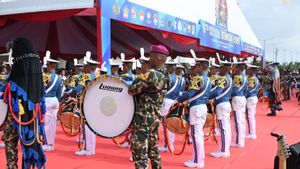JAKARTA - The arrogance of the Civil Service Police Unit (Satpol PP) is seen in one of the worst social tragedies that occurred in 2010 and is known as the 'Bloody Koja'. The clashes led to the hunt for Satpol PP and demands for their disbandment. The civil service officers were barred from wearing uniforms for fear of being targeted by mass attacks.
The tragedy that started with the operation to clear the land of Mbah Priok's sacred tomb made local residents hate the Satpol PP so much. Mbah Priok is a respected religious leader, especially by local residents. Bloody clashes broke out. Satpol PP lost and scared.
The operation to empty the 4.5-hectare sacred tomb by a combination of police officers and the Satpol PP led to disaster on April 14, 2010. Jakarta residents came to the tomb area to prevent the police from dismantling it.
The carefully planned operation was marred by the masses. In the field, task force analysis falls apart. Residents with improvised weapons kept coming to 'defense' the sacred tombs by making them a living fortress.
The head of the Thousand Islands Satpol PP, Hotman Sinambela, who was involved in the bloody incident, still clearly remembers how he and his men were beaten back by the residents. Sinambela to severe trauma. He even jumped over a high fence three times.
Sinambela no longer had time to think about how much loss his party had suffered. The content in his head at that time was only about safety for him and his men.
"Those who have returned with me by sea are only 877 out of 1750 people. I got information that two more bodies were found. However, we don't know the truth yet," said Hotman, quoted by Kompas.com, July 15.
After the bloody clashes, Sinambela was ordered to temporarily deactivate members of the Satpol PP. This was done to prevent them from violence and hunting by residents. Satpol PP members were also asked to take off their official clothes and replace them with civilian clothes.
Urge to disband Satpol PPAfter the bloody clashes, the urge to disband the Satpol PP poured in. The pressure arose because of the accumulation of violations after violations that had been carried out by Satpol PP long ago.
Satpol PP has been considered arrogant and repressive in every effort to control it. Moreover, Satpol PP is often mentioned as an actor who violates human rights. These violations are contained in the form of acts and torture that are inhumane and degrading to human dignity.
At that time, a member of the Golkar House of Representatives Commission I, Fayakhun Andriadi, said that the bloody clashes occurred because the actions of the Satpol PP were always brutal and trampled on human rights. He considered the Satpol PP to work without using their brains. Because of this, the attitude of the Satpol PP is always arrogant and its actions are arbitrary. In fact, the people must be protected, not "beaten" at will.

"Looking at this fact, I agree that the Satpol PP should be disbanded, but before it is disbanded, the head of the Satpol PP must be investigated, he is the one who is most responsible for this bloody raid. We hope that Komnas HAM will immediately investigate this human rights violation in Priok," said Fayakhun was quoted by Tribunnews.
Not only Fayakhun. Another member of the House of Representatives Commission I from PKB, Efendi Choirie, even thought that the actions of the Satpol PP exceeded the cruelty of the Dutch royal army, the KNIL. On the other hand, Choirie saw that the Satpol in carrying out its duties lacked humanism.
Satpol PP, said Choirie, likes thugs like thugs. Whereas Satpol PP should stand to protect the people, not defend foreign interests in the dispute over the land of Mbah Priok's sacred tomb.
"That's what we regret. As civil servants, they should protect the people, not be hostile. Instead of making trouble, there's a point in disbanding them. Everywhere, the presence of Satpol PP is getting more and more disturbing," he said.
Bloody Koja Clash
The common thread of the occurrence of the Bloody Koja Tragedy is a land dispute between PT. Pelindo II and the heirs of Mbah Priok. The DKI Jakarta government then intervened because it agreed with PT. Pelindo II as the legal owner of the land according to the court.
Meanwhile, the heirs and the Priok people think that the tomb should not be disturbed, let alone evicted. Moreover, the existence of heirs of the land has existed since this republic was not yet built.
“The people of Koja who defend this cultural site are, in this perspective, considered 'against the law,' so it seems that the government feels the need to deploy apparatuses that can carry out acts of violence to paralyze their people. In short, the tragedy is the resultant of the legalization of violence by hiding behind policies and legal products,” wrote Laode Ida in the book Negara Mismanagement (2014).
Inevitably, the operation to empty the graves was then carried out by the DKI Jakarta Government on April 14, 2010. In an operation that has a legal basis, the Satpol PP was mobilized on a large scale to ensure the success of the operation. In fact, the planned operation went smoothly and ended in failure.
When the Satpol PP headed towards Mbah Priok's grave, violence was already looming. Residents defending the tomb of religious leaders, have put up makeshift barricades. They also burned wood and tires at the entrance to the tomb parking lot.
Even though Satpol PP came with a fleet complete with excavators to destroy barricades and guard posts. Residents who had armed themselves with knives, sticks, sickles, and bamboo spears were waiting for the command to attack.
Before reaching the tomb gate, the Satpol PP began to be bombarded with Molotov cocktails. Instantly residents then began to attack from close range. Victims from the Satpol PP began to fall. Ambulances went back and forth carrying victims of the clashes.

The atmosphere got hotter when most of the youth groups who were members of the Islamic Defenders Front (FPI) joined the residents in defending the sacred tomb. Their presence was immediately bombarded with tear gas and water cannons.
However, such a method does not make the citizens and FPI subservient. They were even more angry and aggressively carried out attacks that resulted in the loss of lives from both sides.
“At the end of the day, three officers lay dead, more than 70 officers and hundreds of local residents were injured, 80 vehicles were burned or destroyed, and many office buildings in the terminal had their windows shattered and their walls scorched.
"Tens of thousands of vehicles broke down in traffic jams throughout the northern area of Jakarta. Activities at the container terminals stopped, and for days it could not be recovered. Losses were recorded in billions of rupiah," concluded George Quinn in the book Wali Andal Tanah Jawa (2019).
*Read other information about HISTORY or read other interesting articles from Detha Arya Tifada.
Other MEMORIESThe English, Chinese, Japanese, Arabic, and French versions are automatically generated by the AI. So there may still be inaccuracies in translating, please always see Indonesian as our main language. (system supported by DigitalSiber.id)













